Waste to Energy Germany Market Size
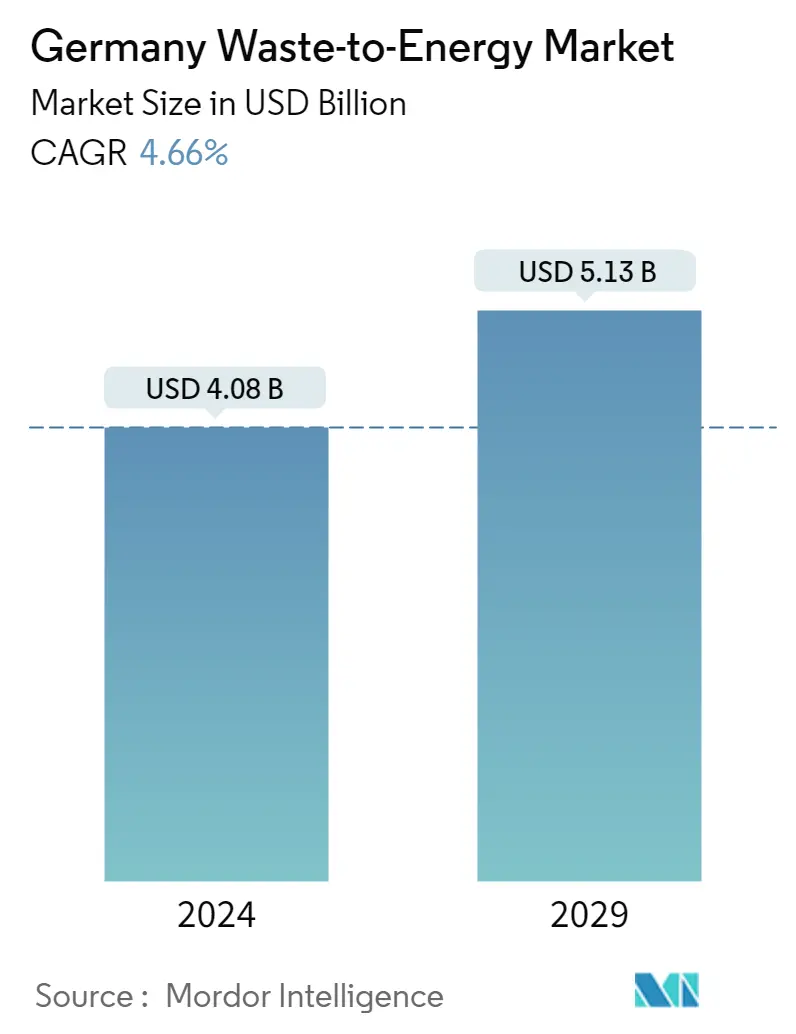
| Study Period | 2020 - 2029 |
| Base Year For Estimation | 2023 |
| Market Size (2024) | USD 4.08 Billion |
| Market Size (2029) | USD 5.13 Billion |
| CAGR (2024 - 2029) | 4.66 % |
| Market Concentration | Medium |
Major Players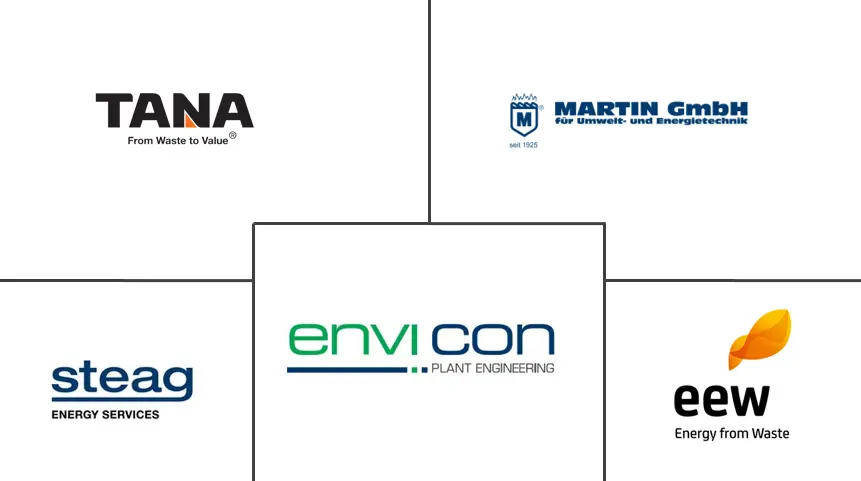
*Disclaimer: Major Players sorted in no particular order |
Need a report that reflects how COVID-19 has impacted this market and its growth?
Waste to Energy Germany Market Analysis
The Germany Waste-to-Energy Market size is estimated at USD 4.08 billion in 2024, and is expected to reach USD 5.13 billion by 2029, growing at a CAGR of 4.66% during the forecast period (2024-2029).
- With the high amount of waste generation becoming a pressing issue in the country, harnessing energy from waste is considered one of the most promising and sustainable solutions for the country's growing electricity and waste management needs. The increasing amount of waste generation, the growing concerns for its management to meet the need for sustainable urban living, and the increasing focus on non-fossil fuel sources of energy have been driving the adoption of the waste-to-energy market in the country.
- However, the recycling rate of waste in Germany remains among the highest in the world and also offers greater economic benefits than waste incineration, which has affected market growth in the country. Besides, the adoption of the resolution by the European Commission to turn Europe into a more circular economy and boost recycling of municipal solid waste to more than 65% by 2035 is expected to affect the market for incineration as well.
The emerging waste-to-energy technologies, such as Dendro Liquid Energy (DLE), which is four times more efficient in terms of electricity generation and has the additional benefit of no emission discharge or effluent problems at plant sites, are expected to create significant opportunities for the market players over the coming years.
Waste to Energy Germany Market Trends
Thermal Based Waste-to-Energy Conversion is Dominating the Market
- Thermal or municipal solid waste incineration involves waste combustion, which generates flue gases. These flue gases produce steam for electricity production and district heating or cooling.
- The primary goal of the incineration process is to reduce the volume and mass of municipal solid waste (MSW) and to make the waste chemically inert in a combustion process without the need for additional fuel. The utilization of the incineration facility is considered economical and productive when the waste collected for the process has a calorific value of more than 7 MJ/kg.
- Regarding technology, thermal processing is among the most popular in the WtE market. Under thermal conditions, incineration is the most prevalent and approved technology. According to the Federal Statistical Office (Destatis), over 156 waste incineration plants were operational in Germany as of 2021. However, due to the lower initial investment, capital cost, and O&M cost per ton, co-processing and gasification are economical options. Future waste streams in Germany are determined by considering the emergence and availability of wastes and residues potentially usable for thermal treatment and the connected capacity developments of energy recovery facilities.
- At present, incineration is the most well-known WtE technology for MSW processing. The gasification and pyrolysis processes produce a combustible synthetic gas (syngas) that can either be used to generate electricity or further refined and upgraded for direct generation in a gas turbine or engine.
- According to International Renewable Energy Agency, in 2022, Germany's total bioenergy installed capacity accounted for 9880 MW, more significant than 9825 MW in 2021. Thus, with increasing bioenergy capacity, Germany's waste-to-energy market is expected to grow.
- On the flip side, Germany has significantly shifted its focus with respect to municipal waste disposal methods from disposal to prevention and recycling. Although municipal waste represents only around 10% of total waste generated in the country, its prevention can reduce the environmental impact during the waste conversion phase and through the life cycle of the products consumed.
- A life-cycle assessment of different waste management options indicates that three to five times more energy can be saved through alternative strategies, such as waste prevention, reuse, recycling, and composting, compared to generating energy by combustion.
- For instance, an incinerator can burn one ton of paper and generate about 8,200 megajoules of energy. However, recycling the same material saves about 35,200 megajoules of energy. As a result, several European countries, including Germany, have started to focus more on recycling, which is restraining the studied market.
- However, the increase in energy generation through waste in Germany could be primarily attributed to the banning of landfills in 2005 due to the rise in methane emissions. The ban on landfills will likely increase demand for waste-to-energy plants to accommodate the waste initially going into landfills.
- Thus, owing to the above points thermal based waste-to-energy conversion is expected to dominating the Market.
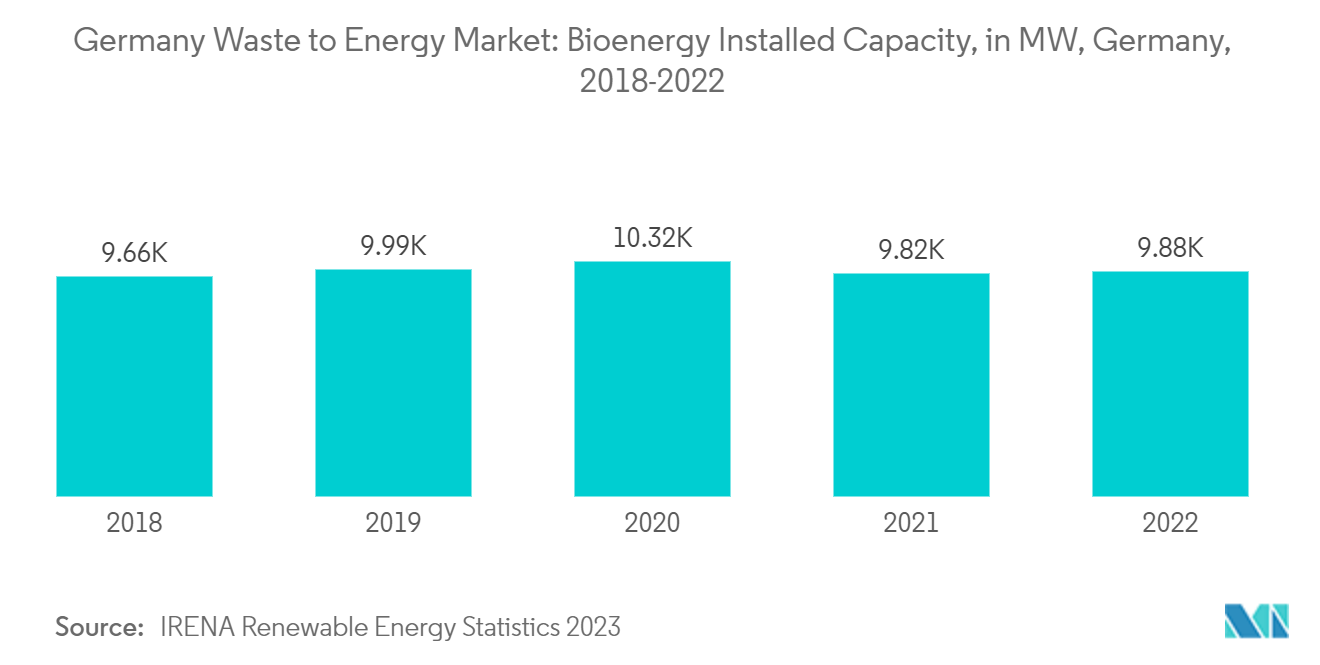
Increasing Recycling Rate of Waste in Germany Expected to Restrain the Market
- Germany has high % recycling rates of 67.6% for household waste and around 70% for industrial and commercial waste. In addition, there are only over 156 thermal waste incineration plants operational in Germany, with a capacity of over 25 million tons, while waste generation is increasing exponentially. Furthermore, there is the limited energy efficiency of waste incineration plants, which is expected to hinder the growth of the waste-to-energy market in the country.
- The recycling rate of waste in Germany remains among the highest in the world and offers more excellent economics than waste incineration, which has affected market growth in the country.
- In addition, the adoption of the resolution by the European Commission to turn Europe into a more circular economy and boost the recycling of municipal solid waste to more than 65% by 2035 is expected to affect the market for incineration as well.
- Moreover, the eventually difficult and expensive disposal of solid combustion residues raises severe environmental concerns. Besides, the insecurity and partly even the lack of long-term stable market conditions for the waste-to-energy market are expected to restrain the growth during the forecast period.
- Thus, owing to the above points, the increasing recycling rate of waste in Germany is expected to restrain the market.
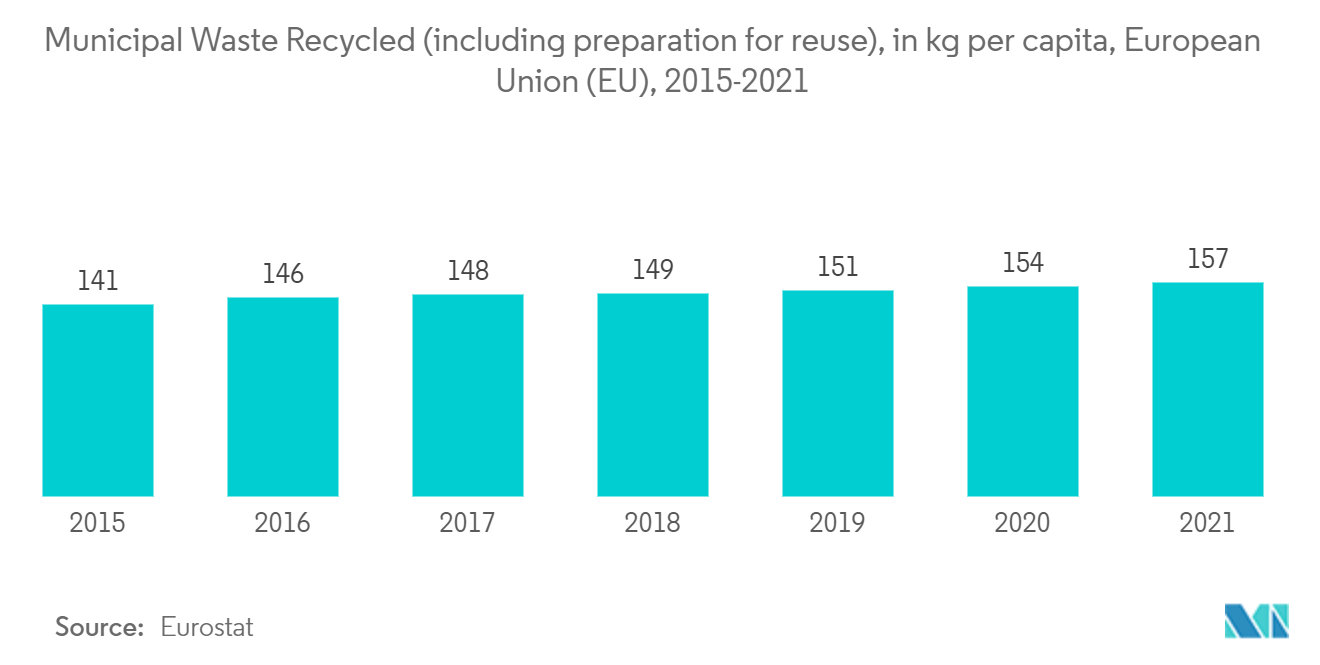
Waste to Energy Germany Industry Overview
The German waste-to-energy market is moderately fragmented. Some of the key players (not in any particular order) include Tana Oy, Martin GmbH, Envi Con & Plant Engineering GmbH, EEW Energy from Waste, and STEAG Energy Services GmbH.
Waste to Energy Germany Market Leaders
Tana Oy
Martin GmbH
Envi Con & Plant Engineering GmbH
EEW Energy from Waste
STEAG Energy Services GmbH
*Disclaimer: Major Players sorted in no particular order
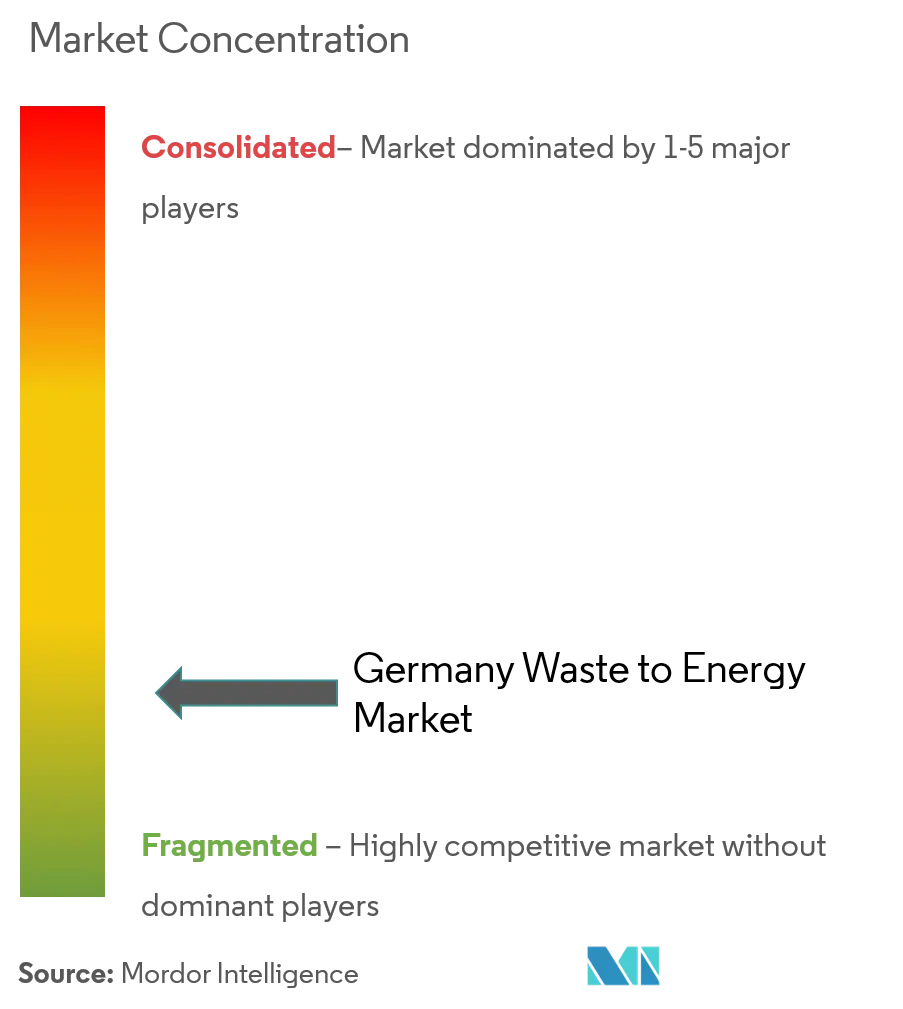
Waste to Energy Germany Market News
- In May 2023, the municipal waste management company Gemeinsames Unternehmen für Abfallwirtschaft (GfA) announced the start of the construction of the waste-to-energy plant in Geiselbullach, located in the state of Bavaria, Germany. The plant aims to tap into geothermal resources to provide an alternative source for the existing district heating network
- In January 2022, Doosan Heavy Industries & Construction Co. received a 160 billion won (USD 134 million) order to construct a waste-to-energy (WtE) plant in Germany, expanding its presence in the rapidly growing European WtE sector. The company stated that its German subsidiary Doosan Lentjes GmbH had obtained the go-ahead from MHKW Wiesbaden GmbH for the project in Wiesbaden, Germany.
Waste to Energy Germany Market Report - Table of Contents
1. INTRODUCTION
1.1 Scope of the Study
1.2 Market Definition and Study Assumptions
2. EXECUTIVE SUMMARY
3. RESEARCH METHODOLOGY
4. MARKET OVERVIEW
4.1 Introduction
4.2 Market Size and Demand Forecasts in USD billion, till 2028
4.3 Recent Trends and Developments
4.4 Government Policies and Regulations
4.5 MARKET DYNAMICS
4.5.1 Drivers
4.5.1.1 The High Amount of Waste Generation in the Country
4.5.1.2 The growing Focus on Non-Fossil Fuel Sources
4.5.2 Restraints
4.5.2.1 The Recycling Rate of Waste in Germany
4.6 Supply Chain Analysis
4.7 PESTLE Analysis
5. MARKET SEGMENTATION
5.1 Technology
5.1.1 Physical
5.1.2 Thermal
5.1.3 Biological
6. COMPETITIVE LANDSCAPE
6.1 Mergers and Acquisitions, Joint Ventures, Collaborations, and Agreements
6.2 Strategies Adopted by Leading Players
6.3 Company Profiles
6.3.1 Tana Oy
6.3.2 Martin GmbH
6.3.3 Envi Con & Plant Engineering GmbH
6.3.4 STEAG Energy Services GmbH
6.3.5 EEW Energy from Waste GmbH
- *List Not Exhaustive
7. MARKET OPPORTUNITIES AND FUTURE TRENDS
7.1 The Emerging Waste-to-Energy Technologies, Such as Dendro Liquid Energy (DLE)
Waste to Energy Germany Industry Segmentation
Waste is any substance or unwanted material resulting from human activity or process. Landfilling and thermal treatment are the most common waste disposal methods in high-income countries, while middle- and low-income countries mostly dispose of waste by open dumping. Waste-to-energy plants turn solid waste into energy, which would otherwise go to landfills. This is done by burning the waste and leaving behind a small amount of ash that can be reused as road or construction aggregate, with the remainder (such as toxic waste) being disposed of in a landfill. WTE plants reduce the burden on the existing landfills and help properly disposal of waste. By technology, the market is segmented into physical, thermal, and biological technology. For each segment, the market sizing and forecasts have been done on the basis of USD billion.
| Technology | |
| Physical | |
| Thermal | |
| Biological |
Waste to Energy Germany Market Research FAQs
How big is the Germany Waste-to-Energy Market?
The Germany Waste-to-Energy Market size is expected to reach USD 4.08 billion in 2024 and grow at a CAGR of 4.66% to reach USD 5.13 billion by 2029.
What is the current Germany Waste-to-Energy Market size?
In 2024, the Germany Waste-to-Energy Market size is expected to reach USD 4.08 billion.
Who are the key players in Germany Waste-to-Energy Market?
Tana Oy , Martin GmbH , Envi Con & Plant Engineering GmbH , EEW Energy from Waste and STEAG Energy Services GmbH are the major companies operating in the Germany Waste-to-Energy Market.
What years does this Germany Waste-to-Energy Market cover, and what was the market size in 2023?
In 2023, the Germany Waste-to-Energy Market size was estimated at USD 3.9 billion. The report covers the Germany Waste-to-Energy Market historical market size for years: 2020, 2021, 2022 and 2023. The report also forecasts the Germany Waste-to-Energy Market size for years: 2024, 2025, 2026, 2027, 2028 and 2029.
Waste to Energy Germany Industry Report
Statistics for the 2024 Waste to Energy Germany market share, size and revenue growth rate, created by Mordor Intelligence™ Industry Reports. Waste to Energy Germany analysis includes a market forecast outlook to 2029 and historical overview. Get a sample of this industry analysis as a free report PDF download.
